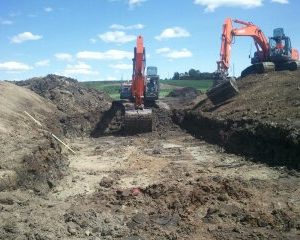The Atterberg limits, created by swedish chemist Albert Atterberg, are the moisture content, in percent, at which the soil changes state. They are defined as:
- Plastic Limit (solid to plastic)
- Liquid Limit (plastic to liquid)
Some textbooks often refer to a third Atterberg limit, the “shrinkage limit” which defines the boundary between “solid” and a further “semi-solid” state, but this is rarely tested and reported in industry.
Since any soil can exist in three possible states based on moisture content (solid, plastic, and liquid), the thresholds between these states is defined as the Atterberg Limits.
Plastic Limit
The threshold between the solid and plastic states is the plastic limit. When a soil has reached its plastic limit it is moldable and easy to change its shape. Plastic soil is like butter – it is not solid but also not liquid.
The ASTM standard for measuring the plastic limit is ASTM D4318, but it is a very simple test that requires no specific lab equipment.
- A sample of soil is rolled into a worm with your hands. The moisture content at which the worm breaks apart with a diameter of 1/8 inch (3.2 mm) is the plastic limit.
- Since it is difficult to pinpoint the moisture content at which to perform the test, usually the test is performed several times with different moisture contents above and below the plastic limit (via adding water or drying in an oven), and the plastic limit is interpolated between them.
This test can be done quickly in the field to determine whether a soil is above or below the plastic limit.
The plastic limit is also used to determine the Plasticity Index.
Liquid Limit
The liquid limit is the point at which the soil stops retaining its shape (flows). As the moisture content increases, the soil will turn from a rigid block into a blob that flows downhill. Eventually, the clay is fully saturated, filling all the pore holes and any additional water is not absorbed.
The ASTM test method for liquid limit involves a standardized lab instrument called a Casagrande cup. A specimen of soil is placed into the cup and a 2 mm groove is cut through the soil with a standard instrument. The cup is repeatedly impacted downwards onto a rubber plate until the groove has been closed for 1/2 inch (12.7 mm). The number of blows is counted. The Liquid Limit is the moisture content at which at which it takes 25 blows to close the groove for 1/2 inch (12.7 mm).
The liquid limit is used in the classification of soils. In the Unified Soil Classifications System (USCS), a liquid limit of 50% or greater differentiates fine grained soils into high and low plasticity categories (CH, MH, and OH vs. CL, ML, and OL). The H and L stand for “high” and “low” respectively.
A soil with a liquid limit of less than 30% will be referred to as “low plasticity.” Greater then 50% will be considered “high plasticity.” Between these values is medium plasticity.
Plasticity Index
The range of water content over which a soil is plastic is an important indicator of its engineering properties. The Plasticity Index is the “size of the plastic range”
- PI = LL – PL
Where:
- PI = Plasticity Index
- LL = Liquid Limit
- PL = Plastic Limit
A high plasticity index means the clay is susceptible to swelling and therefore uplift is a consideration for the design of foundations. Swelling is generally only an issue in clays, specifically Montmorillinite Clay.
Shrinkage Limit
A third Atterberg Limit called the Shrinkage Limit is defined in ASTM D4943 but is rarely used in industry. The shrinkage limit is the point at which the soil begins to gain volume with further increase in moisture content.
ASTM Test Method
The test method for Atterberg Limits is ASTM D4318.
Relevant Types of Soils
The Atterberg Limits are only relevant on fine grained soils (clays and silts). It will be meaningless in gravels because they don’t have a plastic state, only solid and liquid. In theory, sands don’t have a plastic state either, but the Atterberg Limits are often performed on soils that have a high sand component as long as it still contains mostly silt and clay.




Speak Your Mind